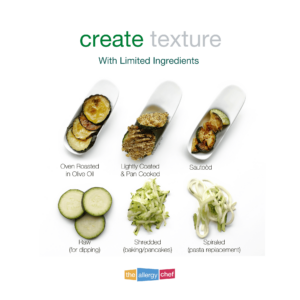I’m sure many of you reading are working with a limited number of known safe foods. If you’re managing a child, and you’re in this boat, you might be concerned about introducing different textures, and you’re right to be. I personally know a few free-from kids where solids had to be delayed due to their diagnosis. By the time the kids could eat solids, many didn’t want to, or presented as extreme picky eaters.
However, we can’t fault them (or their parents). These kids had no point of reference and all of sudden, different foods were served. It was all so foreign to them.
For kids who can have solids, if it’s a limited amount, let’s talk about how you can transform those solids to still provide a range of feeding opportunities.
Temperature Variations
One of the easiest things you can do is vary the temperature of the food. Let’s say a child can have oats. You can do cold overnight oats some mornings, and hot oatmeal on others. You can even bake simple oatmeal bars and serve them at room temperature. That’s now three variations on the same ingredient. Rinse and repeat across as many ingredients as you can.
Cooked vs Raw
Produce can be served cooked or raw, thus creating different texture experiences. With some fruits and veg, you can cook them to the point of mush or keep them on the firmer side. Each step in firmness is a different texture experience for your child.
Lightly Coat Produce
If you have even a basic flour, such as millet four, you can lightly coat vegetables and shallow pan fry in oil/fat. This will create whole new flavour and texture experience for your child.
Shredding and Spiralizing
Both shredding and spiralizing a vegetable gives you new textures to work with. Shredded vegetables can be eaten raw (great for fine motor skills) or baked into something else. You can even add them to pancakes and waffles.
You can spirialize almost any medium-hard/firm vegetable to make a noodle. Some will need to be cooked/baked before consuming such as sweet potato. Your veggie noodles can be eaten raw, or lightly cooked on the stovetop as well.
Oven Roasting & Stove Top Cooking
These are both basic cooking methods that can be applied to the ingredients you have access to. Remember, you can vary the thickness of your slices (or cubes) to create a different experience each time. On top of that, you can alter your cook time. Changing the doneness of the vegetables can alter our perception of taste and texture.
Rotate Through Your Options
Let’s say you have a complex case with only 10 safe foods for now. Of the 10, 6 are produce. With each of the 6, you can apply at least 8 different preparation methods, thus creating 48 variations.
FORTY EIGHT
With the remaining 4 ingredients, get as creative as you can with those as well.
How Do I Know This Works?
As someone who generally has about 9 safe ingredients to work with, I can tell you that these methods work. With my very limited options, I’ve created a huge range of recipes that deliver different taste and texture experiences.
It’s important that you give your kids (and picky eaters) these opportunities because if they’re able to have more in the future, you want them to be able to enjoy food introductions.
Remember, if you’re in a limited ingredient boat, be patient with your kiddos should their diet ever expand. You may need to enlist the help of a feeding therapist or other professional to help make the transition smoother for both you and your child.
I’ll send you off with a quick story. I once passed a food after months of trialing it. That opened the door to several new options, including some “regular” foods most people enjoy. I honest to goodness spat the food out because it registered as completely and utterly disgusting to me. I’m sharing this as an adult who can articulate. Trust me, your kids are going through the same thing, so don’t expect a passed food to be welcomed with open arms.

